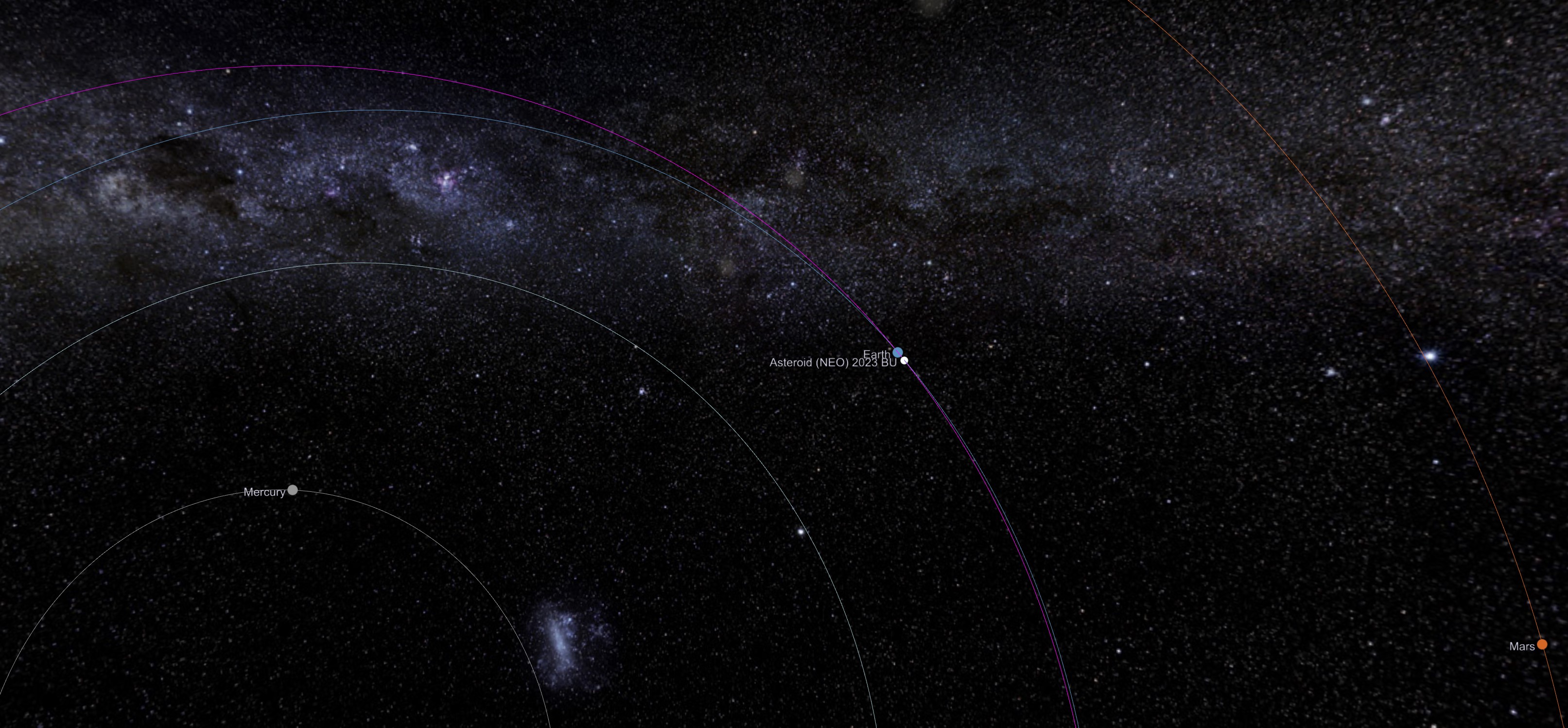Watch asteroid 2023 BU pass close by Earth today in this free webcast
The asteroid will pass between Earth and satellites in geostationary orbit.
Update for Jan. 27: Astronomer Gianluca Masi captured the footage above of the close pass of asteroid 2023 BU as it passed overhead on Thursday (Jan. 26).
A newly discovered asteroid will come very close to Earth this week.
Asteroid 2023 BU measures between 12 and 28 feet wide (3.8 to 8.5 meters), and was just discovered on Saturday (Jan. 21) by astronomer Gennadiy Borisov at the MARGO Observatory in Crimea. When it passes by Earth at its closest on Thursday (Jan. 26) at 4:17 p.m. EST (2117 GMT), the space rock will be within less than 3% of the average Earth-moon distance at an altitude of just 2,178 miles (3,506 kilometers) above Earth's surface.
For comparison, most geostationary satellites orbit at an attitude of around 22,200 miles (35,800 km).
Most asteroids aren't bright enough to be seen without a powerful telescope; luckily, you can watch asteroid 2023 BU make its close encounter with our planet thanks to the Virtual Telescope Project. Astronomer Gianluca Masi will be hosting a free livestream of the asteroid's pass on the project's website or YouTube channel on Thursday (Jan. 26) starting at 5:45 p.m. EST (2245 GMT) after a short delay due to clouds at the project's Ceccano, Italy observing site.
Related: Asteroids: Fun facts and information about these space rocks

Want to look up at Ursa Major and maybe catch a glimpse of asteroid 2023 BU? We recommend the Celestron Astro Fi 102 as the top pick in our best beginner's telescope guide.
The asteroid is currently in the Ursa Major constellation. Due to its small size, asteroid 2023 BU is fairly dim at magnitude 19.15, but it might be visible through a powerful telescope operated by a seasoned skywatcher.
Get the Space.com Newsletter
Breaking space news, the latest updates on rocket launches, skywatching events and more!
Luckily for those of us who aren't veteran asteroid chasers, the Virtual Telescope Project will stream the whole thing. "Asteroid 2023 BU will have an extremely close, but safe, encounter with us, coming [within] less than 10,000 km from the Earth's center, about 25% of the geostationary satellites' distance," writes Masi on the project's website.

Asteroid 2023 BU is known as an Apollo-type asteroid, which means its orbit crosses that of Earth but spends most of its time well outside the path of our planet, according to the Center for Near Earth Object Studies, which is based at NASA's Jet Propulsion Laboratory in Southern California. 2023 BU orbits the sun every 425 days and will not pass close to our planet again until Dec. 6, 2036.
While asteroid 2023 BU will pass extremely close to Earth, it is not categorized as potentially hazardous. That's because its small size means it would likely break up and incinerate in Earth's atmosphere.
Hoping to catch a glimpse of asteroid 2023 BU? Our guides on the best telescopes and best binoculars might help you get started on the path to right optics. You can also check out our guides on the best cameras for astrophotography and best lenses for astrophotography to get started.
Editor's Note: If you manage to catch a photo of asteroid 2023 BU and would like to share it with Space.com’s readers, send your photo(s), comments, and your name and location to spacephotos@space.com.
Follow Brett on Twitter at @bretttingley. Follow us @Spacedotcom, or on Facebook and Instagram.
Join our Space Forums to keep talking space on the latest missions, night sky and more! And if you have a news tip, correction or comment, let us know at: community@space.com.

Brett is curious about emerging aerospace technologies, alternative launch concepts, military space developments and uncrewed aircraft systems. Brett's work has appeared on Scientific American, The War Zone, Popular Science, the History Channel, Science Discovery and more. Brett has English degrees from Clemson University and the University of North Carolina at Charlotte. In his free time, Brett enjoys skywatching throughout the dark skies of the Appalachian mountains.
-
mcswell Given how close its perihelion is to Earth's orbit, any chance this is actually an old booster? If it were > or < white, as most such boosters were, it could be considerably smaller than the estimated 4 to 8 meters.Reply -
bolide Reply
No. An old booster would be in Earth orbit.mcswell said:Given how close its perihelion is to Earth's orbit, any chance this is actually an old booster? If it were > or < white, as most such boosters were, it could be considerably smaller than the estimated 4 to 8 meters. -
mcswell Reply
I should have said upper stage. A year ago, J002E3 turned out to be the Saturn IVb stage from Apollo 12 in an interplanetary orbit (and temporarily re-captured by the Earth).bolide said:No. An old booster would be in Earth orbit. -
bolide Reply
TBH, I wasn't thinking there would be any space junk out there, beyond Earth orbit. But it stands to reason that missions destined for places beyond Earth orbit would leave junk out there, too.mcswell said:I should have said upper stage. A year ago, J002E3 turned out to be the Saturn IVb stage from Apollo 12 in an interplanetary orbit (and temporarily re-captured by the Earth).









